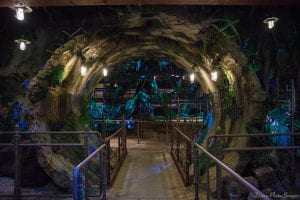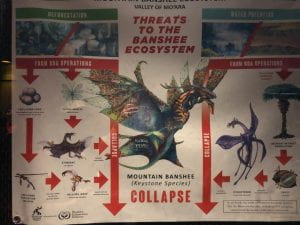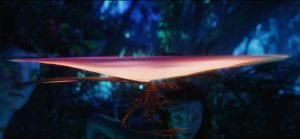
As you stand at the start of the wait line for Flight of Passage, you cannot help but to look up at the floating mountains and be awestruck. It’s not every day that you see enormous boulders floating overhead! After you overcome the initial awe, you hike up a small hill, decorated with wooden effigies of Banshees. The flora’s extraordinary detailed – down to tiny hairs (I couldn’t believe the plants were not alive; I would be surprised if you didn’t believe it). You follow the twisting path, ascending higher: closer to the mountains floating overhead, closer to the draconic Banshees. As you pass underneath a thunderous waterfall, you suddenly enter a softly lit cave. The ritualistic cavern is reminiscent of Neanderthal cave paintings: handprints – human, Na’vi, and Avatar – adorn the walls alongside paintings of native Pandoran wildlife. As you ascend higher, after turning a corner, you enter the cramped, square halls of a mining facility. The fluorescent lights here drill into your soul. There is nothing here but boredom. After you quickly pass through the cramped halls of the mining facility, you enter a slightly more open cavern, overgrown with gorgeous, extraterrestrial bioluminescent fungi. This grotto is an alien forest, with the various ‘plants’ glowing in otherworldly colors: soft blue, pinks, and yellows. The bioluminescent glory cannot be captured by simple words or any length photograph. After a few more turns, you arrive at the Pandora Conservation Initiative’s Lab: the central hub of sustainability and the focus of this essay.
This is the first part of the wait line for Flight of Passage, a new simulator ride at Animal Kingdom. Not only is the wait line a gorgeous trek through the alien moon of James Camron’s Avatar movie, the further in you go, the more you learn about sustainability. The wait line is saturated with environmental messages and themes that explain the history of Pandora and teach about sustainability by applying real world science to the fictional series. You will walk out of the Flight of Passage having learned something about sustainability.
 But first, a quick recap of Avatar, the movie’s protagonist, Jake Sully, rejects the unsustainable way of humanity for the more ‘primitive’ ways of the native Na’vi people. He rises up as their leader and inspires them to drive most humans off of Pandora, the alien moon the Na’vi call home. As such, it’s a surprise to learn that the Valley of Moara is canonical in the series. Although it may seem inconsequential, the Imagineers provided an explanation for why humans are back on Pandora after the events of Avatar: it’s a generation later, and human scientists are helping to reverse the negative consequences of the evil mining corporation’s sustainable mining practices. The ride itself doesn’t contain much sustainability; it’s just a pretty tour of Pandora. Because simulator rides do not take up as much space as a roller coaster, the Imagineers had the space and time to tell a story of sustainability through the wait line.
But first, a quick recap of Avatar, the movie’s protagonist, Jake Sully, rejects the unsustainable way of humanity for the more ‘primitive’ ways of the native Na’vi people. He rises up as their leader and inspires them to drive most humans off of Pandora, the alien moon the Na’vi call home. As such, it’s a surprise to learn that the Valley of Moara is canonical in the series. Although it may seem inconsequential, the Imagineers provided an explanation for why humans are back on Pandora after the events of Avatar: it’s a generation later, and human scientists are helping to reverse the negative consequences of the evil mining corporation’s sustainable mining practices. The ride itself doesn’t contain much sustainability; it’s just a pretty tour of Pandora. Because simulator rides do not take up as much space as a roller coaster, the Imagineers had the space and time to tell a story of sustainability through the wait line.
The greatest and most subtle storytelling comes from the lab; the tests run tell that story. They are based off real environmental issues and designed to educate teenagers and young adults about sustainability.
 The first thing you see, before entering the lab proper, is a food web illustrating the mining corporations impact on the land and the effects on Banshees – a keystone species on the alien moon of Pandora. Keystone Species are essential to the functioning of an ecosystem; without them the ecosystem collapses. The Banshees, like many large predators in the real world, balance the number of individuals in many populations by, well, eating some. They prevent any single population from growing too large and consuming all of the resources. The mining corporation’s destruction of the land has decimated the populations of prey species; in return, severely harming the banshee populations as well. They need to eat after all!
The first thing you see, before entering the lab proper, is a food web illustrating the mining corporations impact on the land and the effects on Banshees – a keystone species on the alien moon of Pandora. Keystone Species are essential to the functioning of an ecosystem; without them the ecosystem collapses. The Banshees, like many large predators in the real world, balance the number of individuals in many populations by, well, eating some. They prevent any single population from growing too large and consuming all of the resources. The mining corporation’s destruction of the land has decimated the populations of prey species; in return, severely harming the banshee populations as well. They need to eat after all!
After this introduction to the problems the mining corporation caused, we get to the main meat of the lab – reversing the mining corporation’s effects. On the central table, water samples are tested for pollutants (specifically the movie’s mcguffin unobtanium). The samples have a high concentration, leading to the next test. The scientists engineered a bacteria that removes contaminants from water. It parallels a real life experiments to enhance the destruction of oil in seawater from oil spills. The bacteria use hydrolysis to break down long hydrocarbon chains (literally eating oil); similarly to how the bacteria on the lab table remove contaminants from water. The bacterial colony on the table differs from the real world bacteria; it’s closer to a small organism in terms of size than an actual bacterial colony. In real life, these colonies are only able to be seen underneath a microscope; where as the containers on the table contain blobs about as big as a human fist. I guess that this decision was made by the Imagineers to give the audience something to look at … and the blob’s random chaotic movements are visually pleasing … so I’m willing to overlook this scientific inaccuracy! After all, how else do you visualize microscopic bacteria?

After the scientific inaccuracy, we move on to the scientific curiosity, the Fan Lizards. The lab is running a reintroduction program for them, a primary food source for the Banshees. The Fan Lizards are first introduced to the lines’ audience through the food web (they’re adorable things in the bottom left corner), and a key part of the ecosystem. The wind tunnel tests the effects of wind on the survival of their eggs and runs predictions on the survival rate. The goal of the reintroduction program is to restore the populations of endangered species to historical levels. By releasing more fan lizards into the wild, they improve the gene pool while adding more, uh, prey for the Banshees.
Where the lab is a master class in show don’t tell, the preflight videos are a perfect example of tell don’t show. Despite my (obvious) disdain, they do do their job: catching up the audience who did not notice the lab tests, as well as explicitly explaining the environmental message. In a way, it is the thesis statement of the line, a quick encapsulation of everything that it’s trying to say. The videos quickly describe the Banshees, claim that they are a keystone species, and then explain the Na’vi ritual the ride’s about. They do not present any additional information, nor do they expand upon any information that is in the lab.
The line’s big problem is mostly solved with the videos: the obscure storytelling of the lab section. The information inside the lab is not described or summarized outside the preflight videos, and piecing information together involves prior knowledge of the subjects (in particular the water cleaning bacteria). When I went through the line, I was in the middle of my AP Environmental Science class, and loved the subtle story telling. My Mom, who was in the line with me, did not understand my exuberance because she lacked the baseline knowledge. If she were to ride the line again, this time with the explanation provided by the videos, she might have a better understanding of the lab section.
Prior knowledge may be important in understanding the line, but sometimes boredom trumps all. What I mean is that the line for Flight of Passage is absurdly long. I waited two hours to ride, and that was at the end of the day when the wait times were trailing off; there has been a recorded wait time of five hours. In a weird way, the popularity of the ride saves the lab. By the time I got to to lab, I was bored out of my mind. I examined the posters on the walls, the diagrams and equipment on the table, and the other minuta in excruciating detail. With horrible cell reception in the line, examining the lab becomes a priority to prevent yourself from going bonkers.
The lab information’s obscurity probably was not intended to be the main way of getting information. Viewing the line as a whole, they likely included the poster, water sample tests, and wind tunnel to make the lab seem cooler and more scientific. However, as an optimist, I prefer to think that they snuck those details in in spite of the limitations rather than because of them. The lab tests draw from real world science to sneakily educate people about real world issues by presenting them through the framework of an alien world. Things like this inspire me to create; this wait line cemented my dream of becoming a Disney Imagineer. In my opinion, the wait line does an extraordinary job educating people about certain aspects of sustainability, even if it does benefit from some luck.
No comments yet.